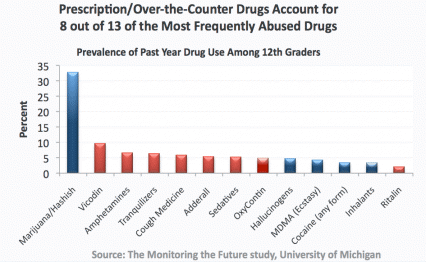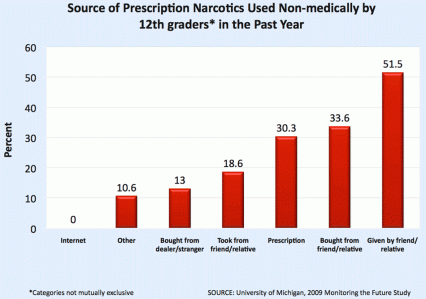The Good News
- In 2009, cigarette smoking continues at its lowest point in the history of the survey on all measures for 8th, 10th, and 12th graders.
- Between 2004 and 2009, a drop in past year use of methamphetamine was reported for all grades.
- Among 10th and 12th graders, 5-year declines were reported for past year use of amphetamine and cocaine. Among 12th graders, past year use of cocaine decreased from 4.4% in 2008 to 3.4% in 2009.
- From 2004 to 2009, decreases were observed in lifetime, past year, past month, and binge use of alcohol across the three grades.
- In 2009, past year use of hallucinogens fell among 12th graders from 5.9% to 4.7%. Past year use of LSD also declined from 2008 to 2009 among 12th graders, from 2.7% to 1.9%. In addition, past year use of hallucinogens other than LSD, also among 12th graders, decreased from 5% to 4.2%.
- Attitudes toward substance abuse, often seen as harbingers of change in use, showed many favorable changes. Among 12th graders, perceived harmfulness of LSD, amphetamines, sedatives/barbiturates, heroin, and cocaine increased. Across the three grades perceived availability of several drugs also declined.
Areas of Concern
- Marijuana use across the three grades has shown a consistent decline since the mid-1990's, but the trend has stalled with prevalence rates remaining steady over the last 5 years. Past year use was reported by 11.8% of 8th graders, 26.7% of 10th graders, and 32.8% of 12th graders. Also, perceived risk of regular use of marijuana decreased among 8th and 10th graders, while perceived availability declined among 12th graders.
- Past year non-medical use of Vicodin and OxyContin increased during the last 5 years among 10th graders; and remained unchanged in 8th and 12th graders. Nearly 1 in 10 high school seniors reported non-medical use of Vicodin; 1 in 20 reported abuse of OxyContin.
- When asked how prescription narcotics were obtained for non-medical use, about 52 percent of 12th graders said they were given to them from a friend or relative; 34 percent bought them from a friend or relative; and 30 percent received a prescription for them; a negligible number of 12th graders reported obtaining them over the internet. Note that respondents were allowed to check multiple sources.
- From 2008 to 2009, lifetime, past month, and daily use of smokeless tobacco increased among 10th graders.
This is also available in PDF format - Download (PDF, 602KB)



